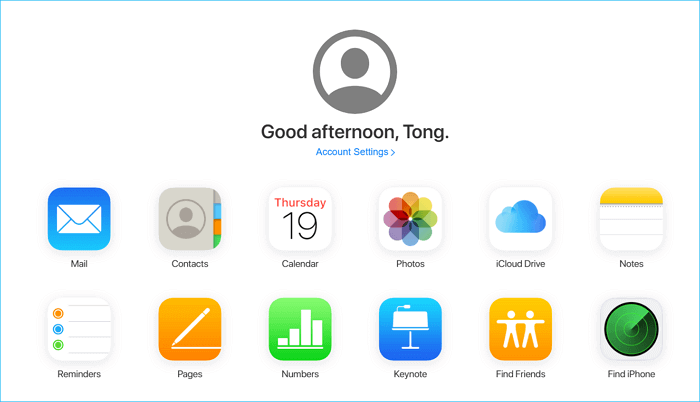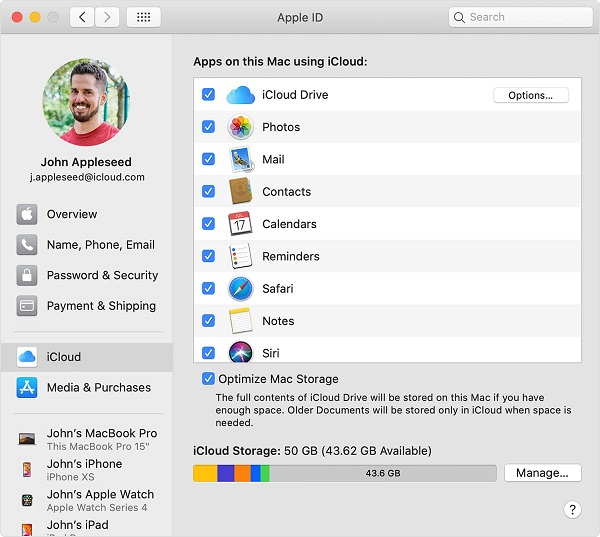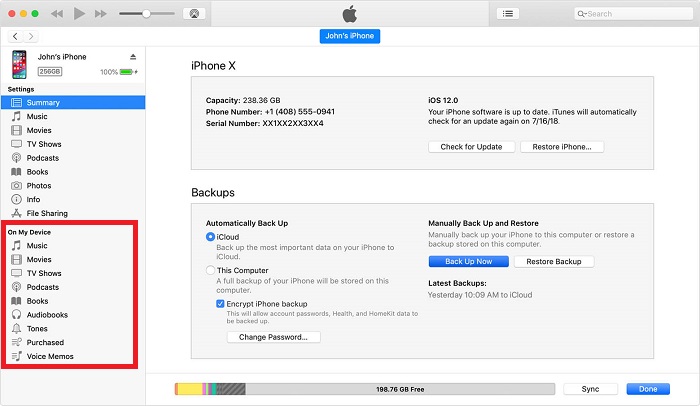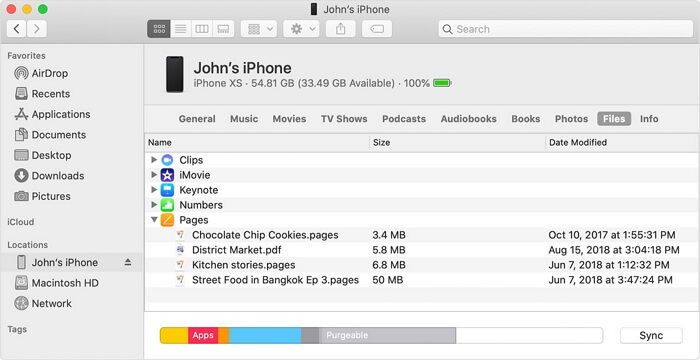How to Access iPhone Files on Mac or PC in 4 Ways
You can make your iPhone files accessible on a PC or Mac in many ways, including iCloud, iTunes, Finder, File Explorer, and the iPhone data transfer tool. All of these ways support different devices and data types. Based on your needs, carry out the way you think would work best for you.
| Solutions | Device | Supported Data |
|---|---|---|
| Qiling MobiMover | Mac & PC | Almost all files on your iPhone |
| iCloud | Mac & PC | Mail, Contacts, Calendar, Photos, Documents, Notes, Reminders, Pages, Numbers, Keynote |
| iTunes | PC & Mac | Videos, Music, Films, TV programmes, Books, Audiobooks, Tones |
| Finder | Mac | Music, Movies, TV Shows, Podcasts, Audiobooks, Books, Photos, Files, Info |
Part 1. How to Access iPhone Files on PC or Mac with Qiling MobiMover
Support files: Photos and Albums, Movies, TV shows, Music Videos, Music, Ringtones, etc
Are you wondering how to access iPhone files on a PC without iTunes? If so, why not try the reliable iOS data management software - Qiling MobiMover, which is designed for iOS data transfer, content management, and video download. With it, you are able to view and access your iPhone/iPad/iPod touch files on PC or Mac, transfer files to or from your iOS device, or download videos from YouTube to your computer or iPhone/iPad/iPad Touch. Here are the files you can view on PC with the help of this tool:
- Photos: Photos and Albums
- Videos: Movies, TV shows, Music Videos
- Audios: Music, Ringtones, Voice Memos, Audiobooks
- Others: Contacts, Notes, Messages, Voice Mails, Books, and Podcasts
To access iPhone files on PC with Qiling MobiMover:
Step 1. Connect your iPhone to your computer with a USB cable, open Qiling MobiMover, click "Content Management" and choose the category you want to view.
Step 2. After you choose the category, you can view all the items existing on your iPhone from your computer. What's more, if you need to, you can transfer files to or from your iPhone using MobiMover.
Step 3. If you want to delete some unwanted files, just select the items and click "Delete", then tap on "Yes" to confirm your deletion.
The files you can view Qiling MobiMover can also be transferred to PC using this tool if you need to. For more details, learn how to transfer files from iPhone to PC with Qiling MobiMover.
Part 2. How to Access iPhone Files on Mac or PC via iCloud
Support files: Mails, Contacts, Calendar, Photos, Notes, Reminders, Pages, Numbers, Keynote
You can view and access iPhone files on Mac or PC via iCloud as long as you've previously enabled iCloud on your iPhone or iPad. The steps vary depending on the computer you're using. Before adopting either of these methods, you need to enable iCloud in advance. To do this, you can:
- Go to Settings on your iPhone or iPad.
- Tap [your name] > iCloud.
- Select the type of content you want to access and toggle it ON.
Then, you can follow these steps to access these data on your Mac or PC.
To access iPhone files on a PC:
Step 1. Open a browser on a PC and visit iCloud.com.
Step 2. Sign in with your Apple ID and passcode.
Step 3. Choose the data type you wish to access. Then, you can see your iPhone files.

If you need to, you can also export contacts from iPhone or download iCloud photos to PC via iCloud.com.
To access iPhone files on a Mac:
In fact, the steps introduced above also work on a Mac, but Apple makes the process easier and quicker. All you need is to enable iCloud sync on your Mac and iPhone, and then you can access synced data on native apps on your Mac. Here're the steps.
Step 1. Click on the Apple icon at the top-left corner of your Mac, and choose "System Preference."
Step 2. Click on the "iCloud" or "Apple ID" option to manage your iCloud account.
Step 3. You'll see all the file types you can sync to your Mac. Just tick the box next to the data you wish to view.
Step 4. Then, you can open your Photos, Notes, Calendar, or other apps to check the synced content.

Tips: If you have ever enabled iCloud Drive on your iPhone, then all of your files and documents will be synced across all of your Apple devices. It is very convenient to access your files with iCloud Drive. But this cloud service works on iPhones or iPad running iOS 13 or later and PC running Windows 10.
Part 3. How to Browse iPhone Files on Mac or PC via iTunes
Support files: Videos, Music, Films, TV programmes, Books, Audiobooks, Tones
If you're using a Mac with macOS Mojave or earlier or a PC, you can use iTunes to access your music, movies, books, voice memos, audiobooks, and more. Here're the steps.
Step 1. Open iTunes on your computer, then connect your iPhone to the computer.
Step 2. When iTunes detects your device, you'll see your device in the left sidebar. Click your device icon.
Step 3. Choose the file you wish to access.

There is more than one solution to access iPhone photos on PC. For more workable tips, go to the guide on how to view iPhone photos on computer.
Part 4. How to View iPhone Photos on PC or Mac via Finder
It's no doubt that the iPhone has better compatibility with Mac, compared with Windows PC. To access iPhone files on Mac, both using Qiling MobiMover and iCloud are advisable. If your Mac is running macOS Catalina, there is one more way for you to browse iPhone files on Mac, which is to use Finder.
Satrt with macOS Catalina, iTunes is not available any longer. Instead, Finder works to share files between your iPhone and Mac. Thus, Finder also allows you to access your iPhone files on Mac.
To view iPhone files on Mac via Finder:
Step 1. Connect your iPhone to the Mac and open a Finder window.
Step 2. In Finder, select your iPhone in the "Locations" section.
Step 3. Choose the tab according to the files you want to view, including music, movies, TV shows, podcasts, audiobooks, books, photos, files, and more.

As mentioned, you can also transfer files from iPhone to Mac or vice versa using Finder:
To copy files from iPhone to Mac: Select the files you want to share and drag the files to a folder on your computer.
To transfer files from Mac to iPhone: Select the files you want to transfer and drag them to the app on your device.
The Bottom Line
Now you know how to access your iPhone files on a computer, be it a PC or a Mac. Besides, you also learn the simple steps to transfer files from your iPhone to PC/Mac or vice versa. I believe these tips will help you at one time or another when it comes to iOS data transfer.
Related Articles
- How to Transfer PDF from iPad to Computer
- How to Download Music on iPhone With or Without iTunes
- How to Backup HP Recovery Partition in Windows 11/10/8/7
There are several ways to backup HP recovery partition, but all with many limitations. To backup recovery partition on any OS, here's an easier way. - Best Way to Backup PC to Cloud in Windows 10 or 11 (FREE)
Need the best free way to backup PC to cloud drive like Google Drive? Try Qiling Disk Master Standard, not only free, but also protect data continuously.